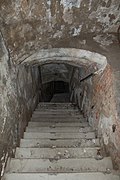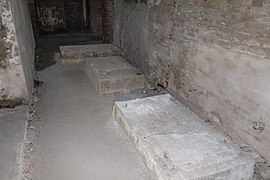Panier bunker
The Paniersbunker or Panierskeller is a former bunker facility in the northern part of the old town of Sebald in the old town of Nuremberg in Bavaria .
description
It is named after the Nuremberg Paniersplatz . The abandoned bunker is part of an extensive cellar system in the northern old town. Since the 14th century, people have been driving tunnels and cellars in the sandstone keuper of Nuremberg Castle Hill . These were used to obtain water for the city and as storage facilities for the local breweries. Originally the cellar system, located ten to twelve meters deep, consisted of independent cellars. From 1940 the cellars were expanded and from 1943 connected by tunnels. To the east, the Paniersbunker is connected to the Tucherkeller and Laufertorkeller via the Tucherstollen .
During the war, the cellars were expanded and served tens of thousands of people as an air raid shelter until American troops marched into Nuremberg in April 1945 . Many Nuremberg residents survived the destruction of their city here on the evening of January 2, 1945. The bunker system itself extends very spacious and is underground with former single cellars such as the Weberskeller , Zeltnerskeller , Stahlkeller to the east and the Greinerkeller , Hirschkopf-Burghardt-Keller to the west as well as Speyerkeller connected. The original cellars, only carved in sandstone, were lined with bricks during the expansion and supplemented with the necessary infrastructure such as toilet facilities, ventilation and supply facilities. The expansion of some sub-areas such as the steel cellar, which was allegedly referred to as the French vault because of the incorrectly bricked vaults by French prisoners of war , was started but not completed. The reason is likely that available building materials became scarce during the chaos of war. These areas were partially filled with rubble and overburden during the construction work.
To the east between the school cellar and the Weberskeller, about at the level of the Johannes-Scharrer-Gymnasium , was the so-called art recovery facility . This area of the bunker, which is around 230 square meters in size, served as a storage location for Nuremberg's art treasures from 1943, alongside the historical art bunker . Here, among other things, the copy and the original of the Nuremberg Neptune Fountain as well as parts of the imperial regalia were stored. The later Nuremberg city architect Heinz Schmeißner hidden yet on Good Friday 1945 crown, orb , scepter and sword of the crown jewels in the underground in vain from the advancing Americans. Several rooms in the western part were used for Gau and party leadership, command posts, aid organizations and municipal authorities.
The bunker is not far from the Nuremberg town hall and was therefore also the alternative quarters of the police town hall guard and the mayor's office . These areas were also much better developed. They were tiled, provided with smooth plaster and some of them were even heatable.
There was also a school bunker in a part that was previously used by the Tucherbrauerei as a warehouse. Girls and boys from the Paniersschule and the neighboring school buildings were housed there. They were also taught there from time to time.
Various lettering can still be seen on the walls. Directional information and room designations such as Grail Cathedral or Noris Grotto were used for orientation and keeping calm or spreading rumors, treason is a typical behavioral rule of the time.
Todays use
After the war, part of the former rescue center in the Speyerkeller was converted into a bathhouse. The operation was soon stopped again. To secure it, part of the system was later insulated with bitumen , lined with shotcrete ( gate-locked ) and in some cases provided with supports. Entrances are still in the elementary school on Paniersplatz and the Johannes-Scharrer-Gymnasium. Some of the former connections, stairways and ventilation shafts were walled up or filled in. Sintering, stalactites and colorful mineral washouts that are well worth seeing have now formed as a result of penetrating water.
Part of the former facility in the Hirschkopf-Burghardt-Keller has housed the Nuremberg Jazz Studio since 1954. Some of the remains of the former ventilation shafts can also be found above ground.
Today, the widely ramified complex is only accessible as part of special tours. As part of the commemoration of the destruction of Nuremberg in January 2005, 2006, 2009, 2015 and 2019, guided tours were offered by the Förderverein Nürnberger Felsengänge eV .
Picture gallery
See also
- Rock passages (Nuremberg)
- Historical art bunker
- Palm courtyard bunker
- Radbrunnen- and Neutorkeller
- Tucherkeller
Individual evidence
- ↑ a b Geology of the Nuremberg Castle Hill , accessed on December 26, 2018
- ^ Förderverein Nürnberger Felsengänge eV, bunker under the Paniersplatz , accessed on December 26, 2018
- ↑ Walter Herppich: The underground Nuremberg . 1st edition. Albert Hofmann, 1987, ISBN 3-87191-301-4 , pp. 132 .
- ↑ www.gs-paniersplatz.de, homepage of the Paniersplatz elementary school , accessed on December 26, 2018
- ↑ www.jazzstudio.de, Homepage of the Jazz Studios Nürnberg , accessed on December 26, 2018
- ↑ www.nordbayern.de, Förderverein: Guided tours through the Paniersbunker , accessed on December 26, 2018
- ↑ www.nordbayern.de, Rescue in the Underworld , accessed on December 27, 2018
- ↑ www.nordbayern.de, In den Tiefen der Stadt: Insight into Nuremberg's bunker world , accessed on December 31, 2018
Web links
- Page about air raid shelters in Nuremberg with photos and information about the panier bunker
- Plan of the rock cellars at Paniersplatz
Coordinates: 49 ° 27 '29.9 " N , 11 ° 4' 50.7" E











